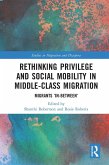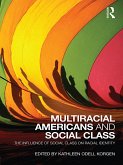Social Class in Europe (eBook, PDF)
An introduction to the European Socio-economic Classification
Redaktion: Rose, David; Harrison, Eric
45,95 €
45,95 €
inkl. MwSt.
Sofort per Download lieferbar

23 °P sammeln
45,95 €
Als Download kaufen

45,95 €
inkl. MwSt.
Sofort per Download lieferbar

23 °P sammeln
Jetzt verschenken
Alle Infos zum eBook verschenken
45,95 €
inkl. MwSt.
Sofort per Download lieferbar
Alle Infos zum eBook verschenken

23 °P sammeln
Social Class in Europe (eBook, PDF)
An introduction to the European Socio-economic Classification
Redaktion: Rose, David; Harrison, Eric
- Format: PDF
- Merkliste
- Auf die Merkliste
- Bewerten Bewerten
- Teilen
- Produkt teilen
- Produkterinnerung
- Produkterinnerung

Bitte loggen Sie sich zunächst in Ihr Kundenkonto ein oder registrieren Sie sich bei
bücher.de, um das eBook-Abo tolino select nutzen zu können.
Hier können Sie sich einloggen
Hier können Sie sich einloggen
Sie sind bereits eingeloggt. Klicken Sie auf 2. tolino select Abo, um fortzufahren.

Bitte loggen Sie sich zunächst in Ihr Kundenkonto ein oder registrieren Sie sich bei bücher.de, um das eBook-Abo tolino select nutzen zu können.
Offering a comprehensive introduction to the new European socio-economic classification this book is based on original research by a distinguished group of international experts from a variety of disciplines. It covers theoretical, methodological, operational and substantive issues, including the use of ESeC in research on health, poverty, deprivation and mobility.
- Geräte: PC
- mit Kopierschutz
- eBook Hilfe
- Größe: 4.01MB
Andere Kunden interessierten sich auch für
![Middle Class Identities and Social Crisis (eBook, PDF) Middle Class Identities and Social Crisis (eBook, PDF)]() Middle Class Identities and Social Crisis (eBook, PDF)41,95 €
Middle Class Identities and Social Crisis (eBook, PDF)41,95 €![Ageing, Austerity, and Neoliberalism (eBook, PDF) Ageing, Austerity, and Neoliberalism (eBook, PDF)]() Amy JonesAgeing, Austerity, and Neoliberalism (eBook, PDF)41,95 €
Amy JonesAgeing, Austerity, and Neoliberalism (eBook, PDF)41,95 €![Rethinking Privilege and Social Mobility in Middle-Class Migration (eBook, PDF) Rethinking Privilege and Social Mobility in Middle-Class Migration (eBook, PDF)]() Rethinking Privilege and Social Mobility in Middle-Class Migration (eBook, PDF)43,95 €
Rethinking Privilege and Social Mobility in Middle-Class Migration (eBook, PDF)43,95 €![Cosmopolitan Spaces (eBook, PDF) Cosmopolitan Spaces (eBook, PDF)]() Chris RumfordCosmopolitan Spaces (eBook, PDF)46,95 €
Chris RumfordCosmopolitan Spaces (eBook, PDF)46,95 €![Multiracial Americans and Social Class (eBook, PDF) Multiracial Americans and Social Class (eBook, PDF)]() Multiracial Americans and Social Class (eBook, PDF)45,95 €
Multiracial Americans and Social Class (eBook, PDF)45,95 €![Routledge International Handbook of Poverty (eBook, PDF) Routledge International Handbook of Poverty (eBook, PDF)]() Routledge International Handbook of Poverty (eBook, PDF)45,95 €
Routledge International Handbook of Poverty (eBook, PDF)45,95 €![Social Cohesion and Immigration in Europe and North America (eBook, PDF) Social Cohesion and Immigration in Europe and North America (eBook, PDF)]() Social Cohesion and Immigration in Europe and North America (eBook, PDF)43,95 €
Social Cohesion and Immigration in Europe and North America (eBook, PDF)43,95 €-
-
-
Offering a comprehensive introduction to the new European socio-economic classification this book is based on original research by a distinguished group of international experts from a variety of disciplines. It covers theoretical, methodological, operational and substantive issues, including the use of ESeC in research on health, poverty, deprivation and mobility.
Dieser Download kann aus rechtlichen Gründen nur mit Rechnungsadresse in A, B, BG, CY, CZ, D, DK, EW, E, FIN, F, GR, HR, H, IRL, I, LT, L, LR, M, NL, PL, P, R, S, SLO, SK ausgeliefert werden.
Produktdetails
- Produktdetails
- Verlag: Taylor & Francis eBooks
- Seitenzahl: 350
- Erscheinungstermin: 4. April 2014
- Englisch
- ISBN-13: 9781134048274
- Artikelnr.: 42669241
- Verlag: Taylor & Francis eBooks
- Seitenzahl: 350
- Erscheinungstermin: 4. April 2014
- Englisch
- ISBN-13: 9781134048274
- Artikelnr.: 42669241
- Herstellerkennzeichnung Die Herstellerinformationen sind derzeit nicht verfügbar.
David Rose is Professor Emeritus of Sociology, Institute for Social and Economic Research, University of Essex. He was academic convener of both the ESRC Review of Government Social Classifications, which led to the creation of the National Statistics Socio-economic Classification, and the of ESeC project, and has published widely on the topic of social class in the UK, including Social Class in Modern Britain (with Gordon Marshall, Howard Newby and Carolyn Vogler, 1988); Constructing Classes (with K. O'Reilly (ed.), 1997); A Researcher's Guide to the National Statistics Socio-economic Classification (ed. with David Pevalin, 2003); and The National Statistics Socio-economic Classification: Origins, Development and Use (with David Pevalin and Karen O'Reilly, 2005). He is an Academician of the Social Sciences. Eric Harrison is Senior Research Fellow in the Centre for Comparative Social Surveys at City University London, UK. He was the assistant convener of the ESeC project, but now works in the ESS coordination team. His principal research interests lie in social stratification, social inequality and comparative research methodology.
Part 1: Introducing the ESeC 1. The European Socio-economic Classification:
A Prolegomenon 2. From Derivation to Validation: Evidence from the UK and
beyond 3. The Application of ESeC to Three Sources of Comparative European
Data Part 2: Measuring Social Class 4. Social Class and Employment
Relations: Comparisons between the ESeC and EGP class schemas using
European data 5. Measuring Social Class: The case of Germany 6. The
Comparative Measurement of Supervisory Status 7. Stable and Consistent with
the Employment Relations' Theoretical Background? Does the prototype ESeC
show these qualities with French data? Part 3: Using ESeC in Comparative
Research on Social Class 8. The Effectiveness of ESeC and EGP in Clustering
Occupations: A study of occupational wage growth in Sweden 9. Class and
Poverty: Cross-sectional and dynamic analysis of income poverty and
lifestyle deprivation 10. Using the ESeC to Describe Socio-economic
Inequalities in Health in Europe 11. Unemployment Risks in Four EU
countries: A validation study of the ESeC 12. Class of Origin and
Educational Inequalities in Contemporary Italy: A validation analysis of
the ESeC Part 4: Conclusions 13. ESeC in Retrospect and Prospect: An
Epilogue
A Prolegomenon 2. From Derivation to Validation: Evidence from the UK and
beyond 3. The Application of ESeC to Three Sources of Comparative European
Data Part 2: Measuring Social Class 4. Social Class and Employment
Relations: Comparisons between the ESeC and EGP class schemas using
European data 5. Measuring Social Class: The case of Germany 6. The
Comparative Measurement of Supervisory Status 7. Stable and Consistent with
the Employment Relations' Theoretical Background? Does the prototype ESeC
show these qualities with French data? Part 3: Using ESeC in Comparative
Research on Social Class 8. The Effectiveness of ESeC and EGP in Clustering
Occupations: A study of occupational wage growth in Sweden 9. Class and
Poverty: Cross-sectional and dynamic analysis of income poverty and
lifestyle deprivation 10. Using the ESeC to Describe Socio-economic
Inequalities in Health in Europe 11. Unemployment Risks in Four EU
countries: A validation study of the ESeC 12. Class of Origin and
Educational Inequalities in Contemporary Italy: A validation analysis of
the ESeC Part 4: Conclusions 13. ESeC in Retrospect and Prospect: An
Epilogue
Part 1: Introducing the ESeC 1. The European Socio-economic Classification:
A Prolegomenon 2. From Derivation to Validation: Evidence from the UK and
beyond 3. The Application of ESeC to Three Sources of Comparative European
Data Part 2: Measuring Social Class 4. Social Class and Employment
Relations: Comparisons between the ESeC and EGP class schemas using
European data 5. Measuring Social Class: The case of Germany 6. The
Comparative Measurement of Supervisory Status 7. Stable and Consistent with
the Employment Relations' Theoretical Background? Does the prototype ESeC
show these qualities with French data? Part 3: Using ESeC in Comparative
Research on Social Class 8. The Effectiveness of ESeC and EGP in Clustering
Occupations: A study of occupational wage growth in Sweden 9. Class and
Poverty: Cross-sectional and dynamic analysis of income poverty and
lifestyle deprivation 10. Using the ESeC to Describe Socio-economic
Inequalities in Health in Europe 11. Unemployment Risks in Four EU
countries: A validation study of the ESeC 12. Class of Origin and
Educational Inequalities in Contemporary Italy: A validation analysis of
the ESeC Part 4: Conclusions 13. ESeC in Retrospect and Prospect: An
Epilogue
A Prolegomenon 2. From Derivation to Validation: Evidence from the UK and
beyond 3. The Application of ESeC to Three Sources of Comparative European
Data Part 2: Measuring Social Class 4. Social Class and Employment
Relations: Comparisons between the ESeC and EGP class schemas using
European data 5. Measuring Social Class: The case of Germany 6. The
Comparative Measurement of Supervisory Status 7. Stable and Consistent with
the Employment Relations' Theoretical Background? Does the prototype ESeC
show these qualities with French data? Part 3: Using ESeC in Comparative
Research on Social Class 8. The Effectiveness of ESeC and EGP in Clustering
Occupations: A study of occupational wage growth in Sweden 9. Class and
Poverty: Cross-sectional and dynamic analysis of income poverty and
lifestyle deprivation 10. Using the ESeC to Describe Socio-economic
Inequalities in Health in Europe 11. Unemployment Risks in Four EU
countries: A validation study of the ESeC 12. Class of Origin and
Educational Inequalities in Contemporary Italy: A validation analysis of
the ESeC Part 4: Conclusions 13. ESeC in Retrospect and Prospect: An
Epilogue







